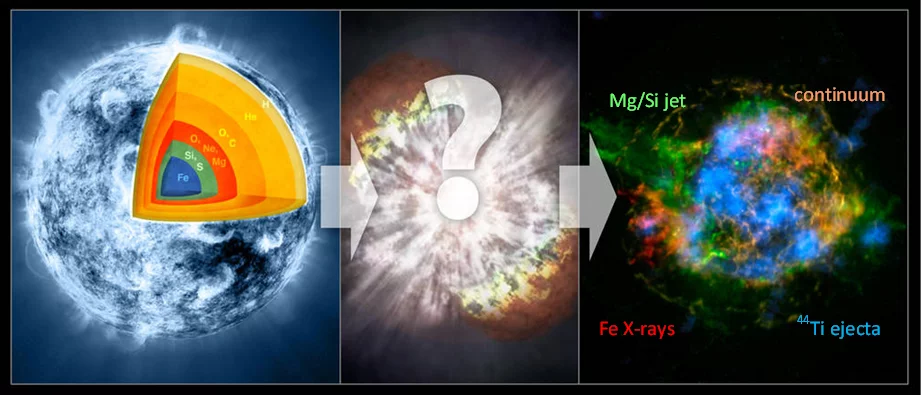Measurement of Neutron capture cross sections and determination of half-lives of short-lived Cosmogenic Radio-Nuclides
The nucleosynthesis of radioactive isotopes in different stages of stellar evolution can be studied either measuring their abundance as still present species, via detection of the emitted radiation or by observing their decay products. Long-lived isotopes with half-lives exceeding 108 a can be still found e.g. in meteoritic material and exhibit the main part of the radioactivity present on the Earth. In contrast, short-lived cosmogenic isotopes with half-lives of less than 108 a are detectable e.g.in meteorites as enrichment of their stable decay products. Some of these radionuclides (e.g. 26Al, 53Mn and 60Fe) have been proven to be present in the early solar system material. In contrast, the direct observation of short-lived isotopes in stars provides a fundamental tool to investigate their production and distribution during different phases of star evolution. The Nuclear Spectroscopic Telescope ARray (NuSTAR) launched at 13th June 2013 gives - at the present day - the best possibility to directly observe freshly produced radioisotopes. A prominent example is the investigation of the Cassiopeia A supernova remnant and the observation of the 44Ti distribution in the ejected cloud of matter (see B.W. Grefenstette, et al: Nature 506 (2014) 339 and B.W. Grefenstette, et al: Astrophys. J. 834 (2017) 19).
The aim of the MeaNCoRN project is the half-life determination of short lived cosmogenic radionuclides with adequate precision for applications. Since neutron induced reactions are among the most important nuclear processes taking place in the stellar environment, additional measurements of neutron induced cross sections are envisaged for those cases where sufficient sample material can be obtained. For this purpose, multidisciplinary collaborations between different research groups at PSI and other international research laboratories were established to perform the required measurements independently from each other or in collaboration. In the course of this project, the collaborations with the neutron time of flight facility (n_TOF CERN, Switzerland), the Physikalisch-Technische Bundesanstalt (PTB-Braunschweig, Germany), the Institute for Applied Physics (Goethe University Frankfurt, Germany), the Institute of Geology and Mineralogy (Cologne, Germany) and the Australian National University (Canberra, Australia) are most important.
The required amount of short lived isotopes (like 26Al, 32Si, 44Ti, 53Mn, 60Fe) exceeds several orders of magnitude the natural abundance but can be extracted from materials irradiated at PSI (see e.g. R.Dressler, et al.: J. Phys. G: Nucl. Part. Phys. 39 (2012) 105201).
The first phase of the MeaNCoRN project, starting in 2005, was concentrated on the astrophysical interesting isotope 60Fe. Since more than 10 years, samples with weighable amounts of 60Fe have been exclusively provided by our group worldwide and used in different measurement campaigns (for detailed references see Results and Highlights).
Our research activities in the future will be focused on the short-lived cosmogenic radionuclides 32Si (t1/2~153 a) and 53Mn (t1/2~3.7 × 106 a).
The radioactive isotope 32Si with a half-life of approximately 153 a (presently available data ranges from 60 a to 360 a) is a cosmogenic nuclide produced in the upper terrestrial atmosphere by bombardment of argon with highly energetic cosmic rays. After this, atmospheric scavenging of soluble and insoluble particles takes place, transferring 32Si quickly to the surface of the Earth. This isotope allows to fill the gap in dating between the relatively short-lived 210Pb (t1/2≈22 a) and the longer-lived 14C (t1/2≈5730 a). Thus, it is a potentially powerful tool to understand environmental processes such as glacier dynamics, ocean and atmospheric circulation, sedimentation in lakes and oceans or groundwater flow in the recent past (100 a – 1000 a). However, the accurate knowledge of the radionuclide`s half-life is a precondition for precise dating. So far, the existing inconsistent data-set on the decay properties of 32Si made its application difficult if not impossible.
During the last 5 years, about 380 g of vanadium-discs were irradiated with protons at PSI, now available as source for about 200 MBq 32Si. We plan to re-determine the half-life of 32Si involving complementary methods of activity measurement like the use of liquid scintillation counters or ionization chambers in combination with different mass spectrometry methods to determine the number of atoms in the samples such as MC-ICP-MS and AMS.
Due to the much longer half-life of 3.7 × 106 a, 53Mn covers - in contrast to 32Si – the evolution history of geological formations e.g. by glaciers and can reveal exposure histories back to 15 × 106 a in the past. On Earth, it is solely produced by spallation processes with highly energetic cosmic particles at iron minerals. However, this might be not the only source of 53Mn. Similar to 60Fe, it can be produced in considerable amounts in supernova explosions and afterwards be introduced into the Solar system and the Earth atmosphere as a kind of “radioactive rain”. Since 1996 intensive research programs were performed to detect both isotopes in deep-sea sediments as evidence for matter injected into the Solar system by nearby supernova explosions. Such signals were observed in the case of 60Fe (see e.g. A. Wallner et al.: Nature 532 (2016) 69 and D. Breitschwerdt et al.: Nature 532 (2016) 73), but until now no indications were found for an excess of 53Mn in these archives. The production of short-lived radioisotopes in the course of supernova explosions depends strongly on the mass and the composition of the precursor star. Under certain conditions, exclusively one of these isotopes can be produced during a single supernova explosion (S. Wanajo et al.: Astro. Phys. J. Lett 774 (2013) L6) giving us the possibility to distinguish between different physical models. To take advantage of such measurements and interpret them either for dating or restricting cosmological models a precise knowledge about the half-lives and reaction cross sections of the involved isotopes is mandatory. Samples containing separated 53Mn in amounts sufficient for such studies are available at PSI.


